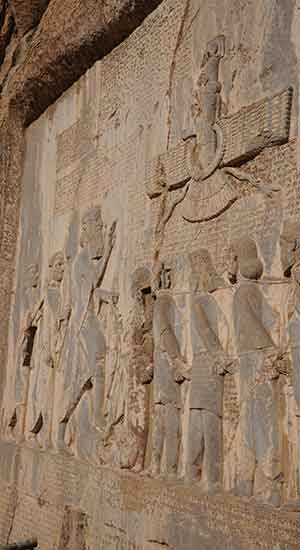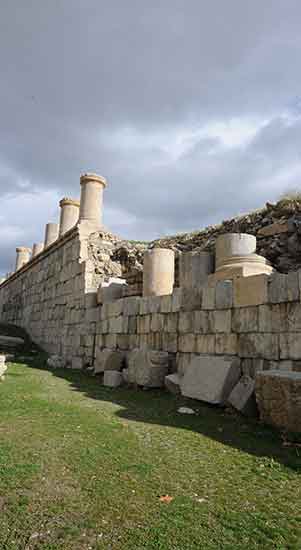KERMANSHAH PROVINCE
KERMANSHAH CITY
10 KERMANSHAH MOST POPULAR CITIES
| Rank | City | Population |
|---|---|---|
| 1 | Kermanshah | 1,083,833 |
| 2 | Eslamabad-e Gharb | 140,876 |
| 3 | Harsin | 78,350 |
| 4 | Javanrud | 75,169 |
| 5 | Sarpol-e Zahab | 85,342 |
| 6 | Sonqor | 81,661 |
| 7 | Paveh | 60,431 |
| 8 | Qasr-e Shirin | 23,929 |
| 9 | Dalahu | 35,987 |
| 10 | Kangavar | 76,216 |

Taq Bostan - Kermanshah
Photographer: Afshin Bakhtiar
A Brief History
The capital of the western Iranian province is Kermanshah, historically known as Bakhtaran. The city is located on the historic caravan route between the Mediterranean Sea and Central Asia and is located in the lush valley of the Qareh River.
Bahram IV of the Sasanian dynasty established it in the fourth century CE. The town was known as Qirmasin when it was conquered by the Arabs in 640. It served as Kordestan's capital throughout the 11th-century Seljuq era. The town was fortified by the Safavids (who reigned from 1501 to 1736), and the Qajars repelled a Turkish siege during Fateh Ali Shah's reign (1797–1834). It was liberated in 1917 after being occupied by the Turkish army in 1915 during World War I. The 1950s saw the building of a road that crossed the ancient Khorasan trail, greatly increasing the city's significance.
Climate and weather
In Kermanshah, the winters are bitterly cold and partially foggy, and the summers are oppressively hot, dry, and clear. The average annual temperature ranges from 26 to 100 degrees Fahrenheit, seldom falling below 17 or rising over 104.
When to Go to Kermanshah?
Mid-June to mid-September is the ideal time of year to travel to Kermanshah for hot-weather activities.
Recommended month for traveling to Kermanshah Province
MAY - JUNE

Bisotun - Kermanshah
Photographer: Afshin Bakhtiar
Where to Go in Kermanshah?
Kermanshah
Kermanshah is one of the most beautiful and historic cities in Iran with many attractions. Among these attractions is Taq Bostan. This attraction consists of two large and small arches and a few beautiful inscriptions from the Sassanid period. This work, which has been registered with a high-water fountain near it, is a good place for tourists. The next attraction is the mirrorwork of the Biggler Beigy, which belongs to the Qajar era. It is also known as the Kermanshah Museum of books and writings.
The next attraction is the flower garden. The garden, with an area of about 2 hectares, has 4 Iranian, Japanese, French, and Italian flower gardens, which include the Cactus, Pond, Waterway, Seasonal Flowers, shrubs, and different species of flowers. The next attraction of the city of Kermanshah is the mountain park near Taq Bostan. This park is one of the largest and most beautiful tourist parks in Kermanshah, with two artificial waterfalls, and a cave called Doashkaft.
Other attractions in Kermanshah include the Tekieh Moaven-al Molk, Sarab Niloufar, Bird Garden, Emad al -Dowleh Mosque, Shafi'i Mosque, Jalili Mosque, Shahbaz Khan Mosque, Imamzadeh Ibrahim.
Paveh
The city of Paveh, dating back more than 6,000 years in the northwest of Kermanshah province, is about 55 kilometers from the capital. The city reaches the north to the city of Marivan and the province of Kurdistan and from the east and south to Javanrood. On the west, Paveh is bordered by Iraq by about 2 kilometers. The city has a temperate mountainous climate and springs, flowing water, forests, rangelands, and lush gardens.
One of the most famous attractions in the city of Paveh is the Ghori Ghaleh Cave 2 km away. This cave, the world's deepest watery cave, has a hall and a beautiful corridor that can attract tourists' attention.
Other attractions of Paveh include the remaining second Iranian fireplace during the Zoroastrian era, which was active 750 years before Islam, the Dokhan Mosque with a linear Quran, the tomb of Sayed Mahmoud Esfahani from the Safavid era, the beautiful village of Hajij. Pierre Ismail in the village of Spires, the beautiful tomb of Sultan Ismaeil near the Sirvan River near the Grand village of Sheikhan, Sheikh Mohammad Aziz Tomb and Najjar Village, etc.
Ravansar
One of the most spectacular cities in Kermanshah province is Ravansar city. The city is also known as the Oramanat gate. Oramanate is an area that is part of it Kermanshah province and has unique natural beauty. Ravansar has an almost warm climate and is located on the slopes of Shaho Mountain, 55 kilometers west of Kermanshah. The most important attraction of this city is Sarab Ravansar. This beautiful lake with a lush atmosphere is one of the most spectacular attractions in Kermanshah province. The lake comes from the largest and tallest river in Kermanshah province called the Gharabsu River. This mirage, which has been nationally registered in Iran, actually originates from the Shaho Mountains.
Salasbabajan
SalasBabajani is one of the border towns of Kermanshah province with many tourist attractions. Most of these attractions are natural and appear more than ever in spring. The city is bordered by Iraq on the west and has about 75 kilometers in common with the country. The very favorable climate and the lush mountains around the city create extremely attractive landscapes. Among the Mountains of the Salas Babajani are Saron, Bani Gaz, Shafilah, Bamu, Dalahu, Noor, Qajar, Dari, and so on. In addition to their special beauty, these mountains also have many medicinal herbs. Salasbabajan also has rivers. Other attractions in the city include the Rizeh Spring, which is 30 kilometers from the center of the city. The water of this spring is useful in the treatment of kidney disease. The next attraction is the beautiful waterfall of Sheikh Salah, located near the border village of Sheikh Salah.
Biston
The city of Bistoon, located 30 kilometers from Kermanshah, is quite historic and spectacular. The most famous attraction of this city is the historic Bistoon complex at the foot of a mountain called Bistoon on Hamedan -Kermanshah Road. In this historic-cultural site, more than 150 monuments have been identified, about 28 of which have been nationally registered. Darius's inscription, also listed on the UNESCO World Heritage List, is also owned by this collection.
Another beautiful work in this collection is the Shah Abbasi inn. The four -porch -style inn with an area of about 6,000 meters last from Shah Abbas to Shah Suleiman. There are towers in the four corners of the building that add to its beauty.
Kangavar
The city of Kangavar, located 92 kilometers east of Kermanshah, has many tourist attractions. It has a temperate climate and is the best time to travel to late September and early fall. Kangavar is full of monuments. These include the famous attraction of the Anahita Temple. The Anahita Temple is one of the largest stone monuments in Iran. This temple belongs to the Parthian or Sassanid period. Other spectacular attractions include Sari Aslan Castle, Hassan Khan Bath, Tavakol Bath, Goodin Tapeh, Historical Koche Bridge, Mirab Fash, Dehler Sarab, Sarab Maran, Sarab Bojan (Khorramabad), Sarab Kabotar Laneh, Historical Mines and Imamzadeh Ibrahim.

Anahita Temple
Photographer: Afshin Bakhtiar
Top Dishes in Kermanshah
Dandeh Kebab
Undoubtedly, the signature of Kermanshah food is Dandeh Kebab. Barbecue ribs are usually served in famous Kermanshah restaurants and there is no special occasion to eat this dish.
Khoresht Khalal
Undoubtedly, Khoresht Khalal is a genuine Iranian food. A popular and chamber food that is compatible with the taste of everyone and is very popular in Kermanshah families. This stew is usually served at special ceremonies such as a wedding. Of course, when family members come together, the stew is one of the best options.
Ingredients for the preparation of Khoresht Khalal: calf thighs, almonds, black barberry, onion, lemon, tomato paste, butter, turmeric, black pepper, salt.
Abas Ali Ash
This Ash is a local cuisine in Kermanshah and the local dialect known as Ash Wesley and has a history of about 200 years. Ash Abbas Ali is usually cooked in the holy month of Ramadan and for Iftar.
Ingredients for this unique ash: mutton, white beans, chickpeas, lentils, wheat grit, Iranian smoked rice, chickpea beans, fried mint, fried onion, fried garlic, Kermanshah oil, salt, pepper, spices Turmeric (all beans must have been soaked in advance).
Soraneh Ash
Ash Souraneh is one of the local cuisines of Kermanshah used in spring. Souraneh is a local spring vegetable that grows in the western parts of the country, mainly Kurdish and in the Zagros foothills.
Ingredients for this ash: Soraneh vegetable, pomegranate paste, salt, turmeric, pepper, and fried onion. Some add some minced meat to the food.
Shalam
One of Kermanshah's local cuisines is a delicious and unique taste, and tasting this delicious soup is not without grace.
Shalam is very similar to tarkhine, but its composition is different. The milled wheat should be cooked, then chopped turnip and turnip leaf. Now in large containers, a layer of cooked wheat and then pour a layer of turnip and chopped turnip leaves. They continue until the container is filled.
Valak polo
Valak is a wild vegetable that grows in the spring in the Zagros Mountains. With this wild vegetable, a delicious pilaf is just called Valak Polo.
Soak the rice in the water for 1 to 2 hours, then crush the clean Valaks. Then fill the pot with half the water and place it on the stove, adding a little salt after boiling it and pouring the rice into the pot. After the rice is cooked, pour the chopped valaks into the pot and wait for 5 minutes to boil with the rice and then rinse the rice.
Koko Paghaze
Paghaze is a local type of spring vegetable that has medicinal properties. Paghaze is used to treat gastrointestinal disease and discomfort.
This is the way Coco Paghaze is preparing. First, the vegetable gets washed and chopped into small pieces and mixed with garlic and onions and special spices, salt, turmeric, as well as eggs, and fry in a pan like a coco. It is so easy to prepare this local food.
Kofte Shirin
Kermanshah Kofteh Shirin is another local cuisine in Kermanshah. It can be prepared quickly and delicious with its low raw materials and has a sweet taste, as its name implies.
The raw materials for the preparation of Kermanshahi sweet meatballs are, minced meat, drain the rice, grated onion, salt, pepper, turmeric, dried mint, water, eggs, and oil. We also use vinegar and sugar to make these Kofteh.
Top Souvenirs of Kermanshah
Nan Berengi
When you arrive in Kermanshah, you can see genuine and delectable Nan Berengi in all stores and pastries. This lovely pastry is made with rice flour, sugar, Kermanshah oil, saffron, butter, and rose water. The price of Kermanshah Nan Berengi varies depending on the quality and number of materials used.
Nan Shekari
Nan Shekari is another delicious and popular Kermanshah pastry. Sugar, oil, salt, vanilla, wheat flour, and eggs are ingredients of this pastry and are usually served in the evening with a cup of hot tea. We suggest that if you travel to Kermanshah, do not neglect the taste of this delicious food.
Kak
If you are looking for a very popular and delicious pastry, Kak is the best choice. Kak sweets are delicious, and you will not regret them if you make souvenirs for your loved ones. The people of Kermanshah provide Kak with a combination of wheat flour, sugar, eggs, cinnamon, oil, cardamom, pistachio powder, coconut powder, almonds, and water. It's not bad to know, in Shiraz, this pastry is called Nan Yokheh.
Handicrafts
Rugs
Kermanshah carpet weaving has long been booming in this land. Rug weaving artists implement beautiful designs such as Cheshmeh Nazami and combined motifs of trees and sparrows, scissors, melons, cashmere, needle, etc. that are derived from nature.
Jajim
Many tribes and villagers use jajim to warm their bodies. This traditional product is woven using wool and you can make the best and most desirable jajim in Oramanate and Salas.
MojBafi
If you are looking for beautiful and colorful fabrics with quadruple designs, Mojbafi fabrics are very suitable. The Rakhtekhab Pij is another name for this wool fabric.
